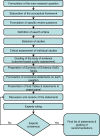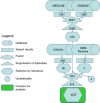The effectiveness of scoliosis screening programs: methods for systematic review and expert panel recommendations formulation
- PMID: 23883346
- PMCID: PMC3737104
- DOI: 10.1186/1748-7161-8-12
The effectiveness of scoliosis screening programs: methods for systematic review and expert panel recommendations formulation
Abstract
Background: Literature on scoliosis screening is vast, however because of the observational nature of available data and methodological flaws, data interpretation is often complex, leading to incomplete and sometimes, somewhat misleading conclusions. The need to propose a set of methods for critical appraisal of the literature about scoliosis screening, a comprehensive summary and rating of the available evidence appeared essential.
Methods: To address these gaps, the study aims were: i) To propose a framework for the assessment of published studies on scoliosis screening effectiveness; ii) To suggest specific questions to be answered on screening effectiveness instead of trying to reach a global position for or against the programs; iii) To contextualize the knowledge through expert panel consultation and meaningful recommendations. The general methodological approach proceeds through the following steps: Elaboration of the conceptual framework; Formulation of the review questions; Identification of the criteria for the review; Selection of the studies; Critical assessment of the studies; Results synthesis; Formulation and grading of recommendations in response to the questions. This plan follows at best GRADE Group (Grades of Recommendation, Assessment, Development and Evaluation) requirements for systematic reviews, assessing quality of evidence and grading the strength of recommendations.
Conclusions: In this article, the methods developed in support of this work are presented since they may be of some interest for similar reviews in scoliosis and orthopaedic fields.
Figures
Similar articles
-
No Recommendation Is (at Least Presently) the Best Recommendation: An Updating Quality Appraisal of Recommendations on Screening for Scoliosis.Int J Environ Res Public Health. 2022 May 30;19(11):6659. doi: 10.3390/ijerph19116659. Int J Environ Res Public Health. 2022. PMID: 35682242 Free PMC article.
-
The Effectiveness of Integrated Care Pathways for Adults and Children in Health Care Settings: A Systematic Review.JBI Libr Syst Rev. 2009;7(3):80-129. doi: 10.11124/01938924-200907030-00001. JBI Libr Syst Rev. 2009. PMID: 27820426
-
Cervical spondylotic myelopathy: methodological approaches to evaluate the literature and establish best evidence.Spine (Phila Pa 1976). 2013 Oct 15;38(22 Suppl 1):S9-18. doi: 10.1097/BRS.0b013e3182a7ebbf. Spine (Phila Pa 1976). 2013. PMID: 24026148
-
Recommendations from the international evidence-based guideline for the assessment and management of polycystic ovary syndrome.Fertil Steril. 2018 Aug;110(3):364-379. doi: 10.1016/j.fertnstert.2018.05.004. Epub 2018 Jul 19. Fertil Steril. 2018. PMID: 30033227 Free PMC article. Review.
-
Are current scoliosis school screening recommendations evidence-based and up to date? A best evidence synthesis umbrella review.Eur Spine J. 2014 Dec;23(12):2572-85. doi: 10.1007/s00586-014-3307-x. Epub 2014 Apr 29. Eur Spine J. 2014. PMID: 24777669
Cited by
-
Screening for scoliosis - New recommendations, old dilemmas, no straight solutions.World J Orthop. 2020 Sep 18;11(9):364-379. doi: 10.5312/wjo.v11.i9.364. eCollection 2020 Sep 18. World J Orthop. 2020. PMID: 32999857 Free PMC article. Review.
-
No Recommendation Is (at Least Presently) the Best Recommendation: An Updating Quality Appraisal of Recommendations on Screening for Scoliosis.Int J Environ Res Public Health. 2022 May 30;19(11):6659. doi: 10.3390/ijerph19116659. Int J Environ Res Public Health. 2022. PMID: 35682242 Free PMC article.
-
The impact of COVID-19 on idiopathic scoliosis referrals: cause for concern.Spine Deform. 2021 Nov;9(6):1501-1507. doi: 10.1007/s43390-021-00418-z. Epub 2021 Oct 1. Spine Deform. 2021. PMID: 34596888 Free PMC article.
-
A systematic review of interventions to support adults with ADHD at work-Implications from the paucity of context-specific research for theory and practice.Front Psychol. 2022 Aug 22;13:893469. doi: 10.3389/fpsyg.2022.893469. eCollection 2022. Front Psychol. 2022. PMID: 36072032 Free PMC article.
-
Association of the IL-6 -174G > C (rs1800795) Polymorphism with Adolescent Idiopathic Scoliosis: Evidence from a Case-Control Study and Meta-Analysis.Rev Bras Ortop (Sao Paulo). 2020 Feb;55(1):17-26. doi: 10.1055/s-0039-1700813. Epub 2019 Dec 19. Rev Bras Ortop (Sao Paulo). 2020. PMID: 32123442 Free PMC article.
References
-
- Goldbloom RB. Canadian Task Force on the Periodic Health Examination: Canadian Guide to Clinical Preventive Health Care . Ottawa: Health Canada; 1994. Screening for Idiopathic Adolescent Scoliosis; pp. 346–354.
LinkOut - more resources
Full Text Sources
Other Literature Sources
Molecular Biology Databases




